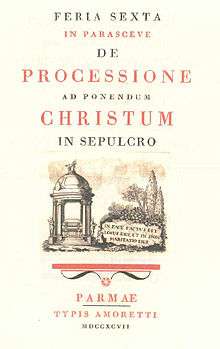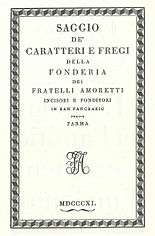Amoretti Brothers
The Amoretti (San Pancrazio Parmense, 18th to 19th centuries) are a family of type-engravers, printers, mechanicians and crafted blacksmiths of the Duchy of Parma. They were friends and pupils of the printer Giambattista Bodoni, from whom they detached in 1791 in order to establish their own printing house and type foundry as competitors of their master.
Amoretti Brothers | |
|---|---|
 Punches of Amoretti Brothers | |
| Born | Amoretti 18th century San Pancrazio Parmense |
| Died | 19th century San Pancrazio Parmense |
| Nationality | Italians |
| Occupation | Engravers, inventors and printers |
| Known for | Bodoni's pupils, engravers and typefounders, printers |
The cooperation with Giambattista Bodoni
At the time Bodoni was called to Parma (1768), several generations of the Amoretti family had been practicing the craft of blacksmiths and mechanics in their native hamlet of San Pancrazio. Their skill was recognized even by the Prime Minister of the Duchy of Parma and Piacenza, Guillaume du Tillot. In 1774 the brothers Pancrace and James received an order by Bodoni to build steel forms to found metal printing types, because the brass ones the printer had commissioned to a watchmaker were losing precision too quickly.
The mandate that Minister Du Tillot stipulated with Bodoni also committed the latter to grow pupils in the art of printing. The printer noticed the ability of James as blacksmith and proposed him to start engraving the punches, that the master would later refine.
Andrea Amoretti, firstborn of Pancrace, helped his uncle James engraving the punches and both worked in the type foundry of the Royal Printing House. He autonomously cut a big deal of Bodoni's punches, including the "Parma" size, the smallest font Bodoni ever proposed and used.
The correspondence between Giambattista and his brother Joseph puts evidence on the friendship between Bodoni and the Amorettis.
The disagreement with Bodoni
In 1791 the Duke of Parma gave Bodoni permission to open a private printing house and the printer turned to the Amoretti for the manufacture of presses, punches and types for his beautiful edition of the Odes of Horace. However, in Parma were circulating rumors, that the Amoretti were not just crafted workers but helped Bodoni in designing and inventing his types: Abbot Andrea Mazza, former librarian of the Duchy of Parma, writing to Girolamo Tiraboschi, the librarian of the Duchy of Modena, assigned to the Amoretti an active contribution to the formation of type Bodoni and to the beauty of Bodoni's print of Horace, issue which is still subject of debate among scholars: "I believed too that our brothers [Pancrazio and Giacomo Amoretti] and their sons [don Andrea and his brothers], the punchcutters, were just executors of Bodoni's drawings and at the beginning it was really like that, despite the task of refining the punches was theirs. However, since the typefaces of Bodoni are making even the stars jealous, the credit entirely goes to the Amoretti."
Experts believe that the Amoretti asked Bodoni the recognition of their work, probably with an indication of their name on his prints, and when he refused they felt betrayed by the master and broke away from him, opening up in San Pancrazio a type foundry and a printing house "co' caratteri dei Fratelli Amoretti", with the support of part of the Court that disliked the "foreigner" Bodoni. When he learned of the casting-workshop ( i.e. foundry ) and typography of the Amoretti - arisen from pupils to competitors - Bodoni became furious and, among mutual blamings of betrayal, was thus fostered the so-called disagreement between them.
The alleged will of Joseph Bodoni, Giambattista's brother, written September 3, 1815, in Saluzzo, states: "If the lawyer acknowledges, with the reason that my brother (Giambattista) was the one who made the types, reply him that Bodoni didn't engrave any type. Those who prepared all the steel pieces to make the punches were Pancratio and James Amoretti, Andrea Amoretti carved those, the aid-de-camp James Amoretti tempered those, beat and justified moulds, and Peter Amoretti was the one that made forms for all types' sizes."
The workshop under the guidance of Don Andrea

From 1791 to 1795, the family Amoretti - i.e. the brothers Pancrazio, James and Francesco and the children of the first, the so-named "brothers Amoretti" Andrea, John, Peter and Victorinus - built all workshop tools needed for producing characters and printing and cutting the punches of their own alphabet.
The printing activities of the Amoretti began in 1795 with the sonnet The Typography, dedicated to the Duke of Parma Ferdinand I of Bourbon, another dedicated to Adeodato Turchi, bishop of Parma, on the occasion of his visit to the workshop in San Pancrazio, and other sonnets.
In 1796 published the Funeral Prayers and Speech on Political Secret of Turchi, so similar to the editions of Bodoni to be exchanged for one of those also by expert eyes.
It is of 1797 the Feria Sexta in parasceve de processione ad ponendum Christum in sepulcro, music book printed in red and black.
The masterpiece of the printing house are the Sonnets about Harmony of Angelo Mazza, printed 1801 and dedicated to Ludwig I of Bourbon, appointed King of Etruria by Napoleon Bonaparte. The printing production of the Amoretti stopped in 1802 with the last volume of the series of works of Giovanni Boccaccio.
The works were always published with the words "co' caratteri de' Fratelli Amoretti" ( with the types of the Amoretti brothers ) or "Typis Amoretti", while the news about the opening of this new workshop, competing with the one of Bodoni, soon spread throughout Italy and the Amoretti s received orders from Parma, Pisa, Genoa, Florence, Livorno, Montefiscone and Bologna, thanks to the elegance of the types that, compared to Bodoni's ones showed greater durability and a slightly lower cost.
Between 1797 and 1799 Bodoni and the Amoretti were struggling to acquire orders from Milan's National Printing House; when Lorenzo Manini was head of the Milanese workshop, the Amoretti received requests for large numbers of types and printing presses. Under the supervision of Giambattista Locatelli who succeeded Lorenzo Manini, Bodoni won the bigger part of the contracts; but each time the creation of Bodoni's typefaces was attributed to the Amoretti, rumours which mainly circulated in Italy and France, the former reacted with anger.
The foundry under the guidance of Francesco

After the death of Don Andrea in 1807, the direction of the workshop was taken over by Francesco Amoretti; the selling business for types and typography tools ( presses, forms, moulds, barrettes, composers, etc. ) thrived, as evidenced by reports of French imperial officials, that were sent to the Paris Government, about the production activities of the Department of the Taro which was a newly formed administrative area, under the Napoleonic regime.
The Saggio de' caratteri e fregi della fonderia dei fratelli Amoretti incisori e fonditori in San Pancrazio presso Parma, ( in English: Sampler of the typefaces, friezes and decorations, from the foundry of the Amoretty brothers, typecutters and founders, in San Pancrazio by Parma ) containing more than 1300 different decorations and characters, was published in 1811. It was followed, after a few years, by the additional Saggio de' fregi della fonderia de' fratelli Amoretti ( Sampler of friezes [ produced by ] the brothers Amoretti foundry ).
These printing catalogues show the work of Don Andrea, "pillar of his family and his workshop," as can be read upon his tombstone.
Victorinus, transfer to Bologna and the epilogue
In 1827 Victorinus remained sole master of the workshop, which was moved from San Pancrazio, an outlying town, to the city of Parma itself where the new, updated catalogue Nuovo saggio de' caratteri e fregi della fonderia dei fratelli Amoretti incisori e fonditori in Parma was published in 1830. The uprisings of 1830-1831 in Parma, led Victorinus Amoretti to accept the enticing invitation of the Papal Authorities to move the foundry to Bologna. There the printing activities continued as the Amoretti foundry was joined to the Sassi Printing House until 1845, when Victorinus died.
His son Joseph held the company until 1863, when his son-in-law Ferdinand Negroni was called to guide it. In 1880 the last became the sole owner and finally changed the brand name to 'Negroni'; subsequently this company was absorbed by the Nebbiolo Enterprises of Turin at the beginning of the 20th century and in 1924 ceased operations altogether.
In their native San Pancrazio Parmense, on the facade of the house that hosted the old workshop, there is an inscription of Professor Umberto Benassi from 1913, the year of the First Bodoni's Celebration. Restored on November 30, 2013, by the local Cultural Association and the Municipality of Parma, on the occasion of the Second Bodoni's Celebrations, it says: In this house / had workshop and home / the Amoretti / valiant ironsmiths, mechanics / typefounders / Don Andrea Amoretti / worthy typecutting pupil and emulator / of the great Bodoni / created here 1795–1807 / types of rare beauty / master to the brothers John/Peter/Victorinus / James / their paternal uncle / first mayor of this Municipality / from March 23, 1806 / equally distinguished cutter of punches / built here watches of admirable precision / the Municipality and citizens wish to remember these former glories of San Pancrazio / MMXIII
Until the '70s the entire stretch of Via Emilia through the hamlet was called "Fratelli Amoretti Street" and when the road name was changed to Via Emilia Nazionale, the name "Via Fratelli Amoretti" was transferred to the alley that leads from the Via Emilia to the churchyard of the parish church.
See also
- History of Western typography
- Letterpress printing
- List of type designers
- Typeface
- Typesetting
- Font (typography)
- Punch (typography)
- Giambattista Bodoni
References
Bibliography
- A. De Pasquale and A. Amoretti, Bodoni e gli Amoretti concorrenti anche a Milano, Parma: Museo Bodoniano, 2013.
- A. De Pasquale, Allievi e antagonisti di Giambattista Bodoni: gli Amoretti di San Pancrazio, Parma: Artegrafica Silva, 2009.
- A. Ciavarella, Una celebre rivalità: i rapporti di bodoni coi fratelli Amoretti di San Pancrazio, "Bollettino del Museo Bodoniano", 4 (1980), pp. 100–104.
- G. Lombardi, Il dissidio di G. B. Bodoni con i suoi migliori allievi: gli Amoretti, «Archivio storico per le Province Parmensi», V (1940), pp. 109–116.
- U. Benassi, Commemorazione di G. B. Bodoni e dei fratelli Amoretti, Parma: Federale, 1913.
External links
- Gemeinsame Normdatei: Fratelli Amoretti (Parma) WorldCat: Fratelli Amoretti, firm, typefounders, Parma WorldCat: Amoretti, Fratelli WorldCat: Amoretti, Frères
- Parma and San Pancrazio, Second Celebrations of Bodoni and Amoretti, November 30th 2013
- Bodoni Museum in Parma, Amoretti Exhibition 2009
- Encyclopedia Treccani, Amoretti of San Pancrazio